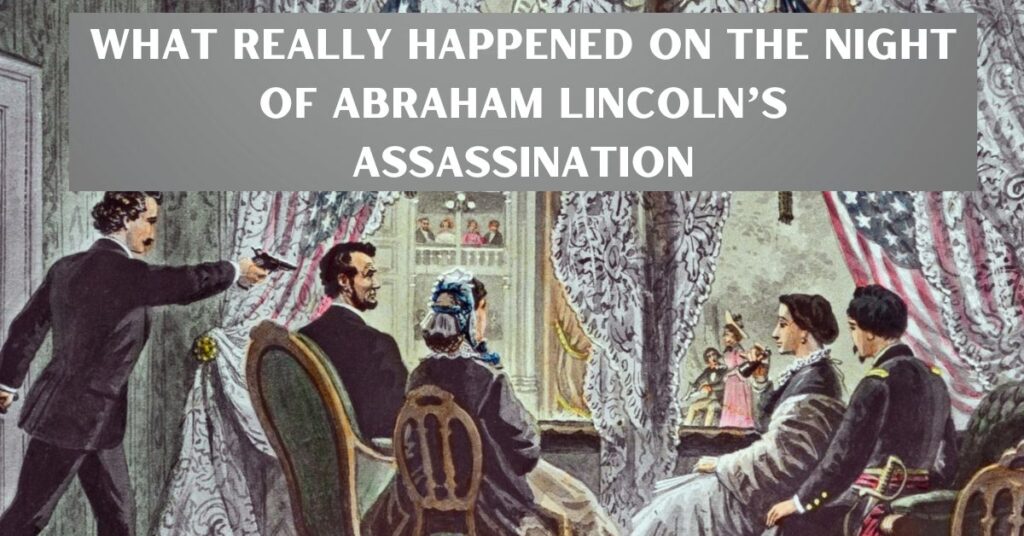In this article, we’ll take a captivating journey through the fateful night of Abraham Lincoln’s assassination and the events that followed. We’ll delve into the life of John Wilkes Booth, the man behind the tragic event, and explore the motives that led him to commit this heinous act. As we unravel the conspiracies and key players surrounding the assassination, we’ll also shed light on the impact it had on American history and the legacy of Lincoln himself. Join us as we step back in time and uncover the gripping story behind one of the most pivotal moments in U.S. history.
Table of Contents
Abraham Lincoln’s last days
In this section, we’ll take a closer look at the President’s last speech, his plans for Reconstruction, and the atmosphere in Washington D.C. during that fateful period. By gaining a deeper understanding of Lincoln’s thoughts, actions, and the prevailing mood of the nation, we can better appreciate the magnitude of his untimely death and its impact on the course of American history. So, let’s step back in time and immerse ourselves in the poignant last days of one of America’s most iconic leaders.
Lincoln’s last speech
On April 11, 1865, just days before his assassination, President Lincoln delivered his final speech from the White House balcony. Addressing a crowd of expectant listeners, he discussed the critical issue of Reconstruction following the Civil War. Though the audience anticipated a celebration of the recent Union victory at Appomattox, Lincoln took the opportunity to outline his vision for a unified America.
The President emphasized the need for a smooth reintegration of Confederate states back into the Union, as well as the importance of granting suffrage to African American citizens. In his speech, Lincoln explicitly supported voting rights for educated African Americans and those who had served in the Union Army. This public declaration marked a significant step forward for civil rights in the United States.
Lincoln’s last speech was a testament to his commitment to rebuilding the nation on a foundation of equality and unity. It offered a glimpse into the path he intended to follow for Reconstruction had he not been tragically assassinated just a few days later. The address is remembered not only for its historical significance but also for the poignancy of its timing, as it marked the final words of a leader who was taken too soon.
Plans for Reconstruction
Lincoln’s approach to Reconstruction was rooted in his desire to heal the nation’s wounds and promote unity. His plan, often referred to as the “10% Plan,” aimed to facilitate the smooth reintegration of Confederate states back into the Union. Under this plan, a state could rejoin the Union once 10% of its voters pledged loyalty to the United States and agreed to abide by emancipation.
This lenient approach was met with opposition from the Radical Republicans in Congress, who sought a more punitive and stringent policy towards the former Confederate states. They insisted on the passage of civil rights legislation and constitutional amendments to ensure the rights of newly freed slaves were protected.
Lincoln’s vision for Reconstruction also included the establishment of the Freedmen’s Bureau, an organization that would provide assistance to former slaves and destitute white citizens in the South. The bureau’s mission was to help with education, healthcare, and employment opportunities, fostering a more equitable society in the aftermath of the war.
Though Lincoln did not live to see his plans for Reconstruction fully implemented, his moderate approach laid the foundation for the initial policies that followed. Unfortunately, after his assassination, the more punitive Radical Reconstruction took hold, leading to a long and tumultuous period of adjustment for the nation.
The mood in Washington D.C
In the days leading up to Lincoln’s assassination, the mood in Washington D.C. was a mix of celebration and apprehension. With the end of the Civil War in sight, the city was buzzing with excitement over the Union’s impending victory. The streets filled with jubilant citizens, and the atmosphere was one of hope and relief.
However, underlying the celebrations was a sense of uncertainty about the future. Reconstruction was a daunting task, and the nation faced the challenge of rebuilding both its economy and its social fabric. Tensions were also high between different factions in the government, with disagreements about the best way to approach the reintegration of the Southern states and the protection of newly freed slaves.
In this volatile environment, Lincoln’s assassination further shocked and devastated the nation. His death left an enormous void in leadership, and the country mourned the loss of the man who had guided them through their darkest hour. The grief and confusion that followed his assassination only served to intensify the challenges that lay ahead for the United States during the difficult period of Reconstruction.
John Wilkes Booth and the conspirators
In this section, we’ll delve into the lives of John Wilkes Booth and his fellow conspirators, exploring their backgrounds, motives, and the fateful decisions that led them to become entwined in one of the most infamous events in American history. We’ll shed light on the man who pulled the trigger, as well as the key players who supported his deadly mission. Join us as we uncover the chilling story behind the assassination of Abraham Lincoln and the individuals who sought to change the course of history with a single act of violence.

Background of John Wilkes Booth
John Wilkes Booth, the man responsible for Lincoln’s assassination, was born on May 10, 1838, in Maryland. Hailing from a prominent theatrical family, he followed in his father’s footsteps, becoming a successful stage actor known for his good looks, charismatic presence, and dramatic flair. His older brother, Edwin Booth, was considered one of the greatest actors of his time.
Despite his flourishing career, Booth harbored strong political views, particularly regarding the issue of slavery. A staunch supporter of the Confederacy, he vehemently opposed Lincoln’s presidency and the abolitionist movement. As the Civil War unfolded, Booth’s resentment towards Lincoln grew, fueled by the President’s policies and the Union’s military successes.
Booth’s initial involvement in anti-Lincoln activities was limited to expressing his discontent in letters and conversations. However, as the war progressed and his animosity deepened, he became increasingly consumed by the idea of taking drastic action against the President. Booth’s background in the theater would ultimately play a significant role in his meticulously planned and executed assassination plot, as his skills in deception and drama proved to be valuable assets in his deadly mission.
Booth’s motives
Understanding Booth’s motives for assassinating President Lincoln requires a deep dive into his political beliefs and personal convictions. Booth’s staunch support for the Confederacy and the institution of slavery played a significant role in driving him towards such a drastic act.
Booth viewed Lincoln as a tyrant who sought to destroy the Southern way of life, particularly in regard to slavery. He was infuriated by the Emancipation Proclamation, which declared freedom for slaves in Confederate-held territories, and Lincoln’s push for the passage of the 13th Amendment, which aimed to abolish slavery in the United States.
Furthermore, Booth’s resentment was fueled by the Union’s victories on the battlefield, especially the fall of Richmond, the Confederate capital. He perceived these events as threats to the cause he passionately supported, leading him to believe that drastic measures were necessary to avenge the Confederacy and preserve the Southern way of life.
Booth also held white supremacist views, considering African Americans as inferior and opposing their civil rights. Lincoln’s advocacy for voting rights for educated African Americans and those who had served in the Union Army only served to further enrage Booth.
In essence, Booth’s motives were a complex mix of political, ideological, and personal factors. His deep-seated convictions, combined with his increasing frustration and desperation, ultimately culminated in the decision to assassinate President Lincoln, an act he believed would strike a powerful blow against the Union and alter the course of history.
Other key conspirators: Mary Surratt, Lewis Powell, and David Herold
John Wilkes Booth’s assassination plot involved several other key conspirators who played crucial roles in the plan’s execution. Let’s take a closer look at three of these individuals: Mary Surratt, Lewis Powell, and David Herold.
Mary Surratt

Mary Surratt owned a boarding house in Washington D.C., which served as a meeting place for Booth and his co-conspirators. She was a Confederate sympathizer, and her establishment provided a discreet location for the group to plan their activities. Surratt was also the mother of John Surratt, a fellow conspirator who managed to evade capture. Following the assassination, Mary Surratt was arrested, tried, and found guilty of conspiracy. She became the first woman to be executed by the United States federal government.
Lewis Powell

Lewis Powell, also known as Lewis Payne or Lewis Paine, was a former Confederate soldier who joined Booth’s conspiracy. He was assigned the task of assassinating Secretary of State William H. Seward on the same night as Lincoln’s murder. Although Powell managed to attack Seward, his efforts were ultimately unsuccessful, as Seward survived the assault. Powell was later captured, tried, and executed for his role in the conspiracy.
David Herold

David Herold was another important member of the assassination plot. He was tasked with guiding Lewis Powell out of Washington D.C. after the attack on Seward. Herold later accompanied Booth during his attempt to escape, leading him through the swamps of Maryland and Virginia. The pair was eventually cornered in a tobacco barn, where Herold surrendered, while Booth was fatally shot. Herold was tried and executed for his involvement in the conspiracy.
These three individuals, along with others, played critical roles in Booth’s deadly plan, each contributing their skills and resources to the plot that would shake the nation to its core.
The assassination at Ford’s Theatre
In this section, we’ll take you on a gripping journey through the fateful night of April 14, 1865, when President Abraham Lincoln was assassinated at Ford’s Theatre. We’ll detail the chilling events that unfolded, from Lincoln’s arrival at the theater to the moments following his tragic death. Along the way, we’ll paint a vivid picture of the atmosphere inside Ford’s Theatre, the actions of John Wilkes Booth and his fellow conspirators, and the immediate aftermath of the shocking event that changed the course of American history forever.

The evening of April 14, 1865
On the evening of April 14, 1865, just days after the Confederate surrender at Appomattox, Washington D.C. was in a celebratory mood. President Abraham Lincoln and his wife, Mary Todd Lincoln, decided to attend a performance of the popular comedy, “Our American Cousin,” at Ford’s Theatre. Accompanying them were Major Henry Rathbone and his fiancée, Clara Harris.
The President’s attendance was publicized, and the theater was filled with excited patrons eager to catch a glimpse of Lincoln. Booth, an actor familiar with Ford’s Theatre, was well-aware of the play’s layout and had carefully planned his moves. He knew this evening presented a prime opportunity to execute his sinister plan.
Before the play began, Lincoln arrived and settled into his box seat, which was adorned with patriotic bunting and a portrait of George Washington. The audience gave him a standing ovation, and he graciously acknowledged their applause. Little did they know, these would be some of the President’s final moments in public.
As the play progressed, Booth prepared for his deadly mission. He had arranged for an accomplice to hold his horse near the theater’s back entrance, and he quietly entered the building, armed with a single-shot Deringer pistol and a knife. Booth’s familiarity with the theater allowed him to move stealthily, avoiding detection as he made his way towards the President’s box.
Lincoln’s arrival at Ford’s Theatre
President Lincoln’s arrival at Ford’s Theatre on April 14, 1865, was an event eagerly anticipated by the audience. As he entered the theater accompanied by his wife, Major Henry Rathbone, and Clara Harris, they were led to the Presidential Box, a private balcony decorated with flags and a portrait of George Washington.
The play was temporarily halted as the orchestra played “Hail to the Chief,” and the audience rose to their feet, offering thunderous applause and cheers. Lincoln, ever gracious and humble, acknowledged the crowd with a warm smile and a nod before taking his seat in the box.
The President’s presence in the theater was a symbol of hope and unity for a nation emerging from the devastation of the Civil War. As the audience settled back into their seats, the play resumed, and laughter filled the theater. Little did they know that the evening’s tragic events would soon unfold, leaving an indelible mark on American history.
John Wilkes Booth’s entry and assassination attempt
As the play continued to unfold, Booth meticulously prepared for his assassination attempt. He had previously visited Ford’s Theatre to ensure he knew the layout, and this familiarity allowed him to move stealthily within the building. Knowing when the play would reach its loudest and most humorous scene, Booth timed his entry to the Presidential Box to coincide with this moment.
Booth approached the box, quietly slipping past the unguarded door. Charles Forbes, a footman, and an off-duty police officer named John Parker had been assigned to protect the President, but both were absent from their posts. This lapse in security provided Booth with the opportunity he needed.
Once inside the box, Booth barricaded the door behind him using a wooden beam he had prepared earlier. He then silently crept towards the unsuspecting President. As the audience roared with laughter at a particularly funny line, Booth took advantage of the distraction, raised his Deringer pistol, and fired a single shot into the back of Lincoln’s head.
Major Rathbone, who was seated with the President, immediately sprang into action, attempting to apprehend Booth. However, Booth slashed Rathbone with a knife, inflicting a severe wound before leaping onto the stage. Despite breaking his leg during the jump, Booth managed to shout “Sic semper tyrannis!” (Thus always to tyrants!) before limping off the stage and escaping the theater.
In just a matter of moments, Booth’s calculated attack had plunged Ford’s Theatre into a state of chaos and confusion. The tragic event that unfolded that night would leave a permanent scar on the nation’s psyche, forever changing the course of American history.
The immediate aftermath
In the moments following the assassination, Ford’s Theatre was engulfed in panic and confusion. As the gravity of the situation became apparent, audience members and theater staff rushed to aid the mortally wounded President. Dr. Charles Leale, a young Army surgeon in attendance, quickly took charge of the situation, attending to Lincoln and assessing the severity of his injury.
With the realization that the President needed urgent medical care, a group of men, including Dr. Leale, carefully carried Lincoln across the street to the Petersen House, a nearby boarding house. They laid him down on a small bed, his tall frame hanging over the edges, as Dr. Leale and other doctors worked tirelessly to stabilize him.
Meanwhile, the news of the assassination attempt spread like wildfire throughout Washington D.C. As the city’s residents grappled with shock and disbelief, authorities launched a massive manhunt for Booth and his co-conspirators. The night’s events didn’t end with Lincoln’s assassination; a simultaneous attack was carried out on Secretary of State William H. Seward, who was stabbed multiple times but survived the assault.
Back at the Petersen House, doctors concluded that Lincoln’s wound was too severe for him to recover. The President remained unconscious throughout the night, with his family and members of his cabinet keeping a somber vigil by his bedside. On April 15, at 7:22 a.m., Abraham Lincoln took his final breath, forever etching this tragic day in the annals of American history.
The pursuit and capture of the conspirators
In the wake of the shocking assassination of President Abraham Lincoln, a manhunt of unprecedented scale was launched to track down John Wilkes Booth and his fellow conspirators. This thrilling pursuit would lead authorities through a perilous web of clues, false leads, and near misses, as the nation grappled with the loss of its beloved leader. The following sections will recount the gripping tale of how law enforcement agents worked tirelessly to bring those responsible for this heinous act to justice, shedding light on the fate of Booth and his co-conspirators as they tried to evade capture.
The manhunt for John Wilkes Booth
The manhunt for John Wilkes Booth began immediately after the assassination of President Lincoln. A massive search operation was launched, involving thousands of troops, detectives, and civilians. The pursuit was one of the most extensive and well-documented manhunts in American history. As Booth fled south, he was accompanied by David Herold, one of his co-conspirators.
Capture and death of Booth
Twelve days after the assassination, on April 26, 1865, Booth and Herold were finally cornered in a tobacco barn on the Virginia farm of Richard Garrett. Herold surrendered, but Booth refused to give up. The barn was set ablaze to force Booth out, but he still refused to surrender. A Union soldier, Sergeant Boston Corbett, shot Booth in the neck, claiming he had fired in self-defense as Booth raised his weapon. Paralyzed and mortally wounded, Booth was dragged from the barn and died a few hours later.
Arrest and trial of other conspirators
In the days following the assassination, several other conspirators were arrested, including Mary Surratt, Lewis Powell (also known as Lewis Payne), and George Atzerodt. They were charged with conspiring to assassinate the President, Vice President, and Secretary of State. The trial was held before a military commission, as the government considered the assassination to be an act of war.
Execution of Mary Surratt, Lewis Powell, David Herold, and George Atzerodt
After a highly publicized trial, Mary Surratt, Lewis Powell, David Herold, and George Atzerodt were found guilty and sentenced to death. On July 7, 1865, they were hanged at the Old Arsenal Penitentiary in Washington, D.C. Mary Surratt became the first woman to be executed by the U.S. federal government. The remaining conspirators were either sentenced to life in prison or shorter terms, with some eventually pardoned.
The capture and execution of the Lincoln assassination conspirators marked a crucial chapter in the aftermath of the tragic event. The swift and resolute actions of the authorities to bring the perpetrators to justice demonstrated the government’s determination to hold those responsible for the heinous act accountable.
Lincoln assassination conspiracy theories
The assassination of President Abraham Lincoln has captivated the minds of historians, scholars, and the general public for more than a century. While the tragic events of April 14, 1865, are well-documented, the possibility of alternative explanations and hidden motives behind the assassination has given rise to numerous conspiracy theories. These theories seek to explore and question the official narrative, delving into the potential involvement of larger groups or individuals who might have played a role in the assassination plot. In this section, we will examine some of the most prominent conspiracy theories surrounding Lincoln’s assassination, evaluate their validity, and attempt to understand the reasons behind their enduring appeal.
Possible involvement of Confederate leaders
One prevalent conspiracy theory suggests that Confederate leaders, including President Jefferson Davis, played a role in orchestrating the assassination of Abraham Lincoln. According to this theory, Confederate sympathizers aimed to destabilize the Union government by eliminating its leader, thus paving the way for the Confederacy to regain power. However, historical evidence has not conclusively linked any high-ranking Confederate officials to the assassination plot, and the theory remains largely speculative.
The theory of a larger conspiracy
Another popular theory posits that the assassination was the result of a larger conspiracy involving multiple co-conspirators beyond John Wilkes Booth and his known associates. Proponents of this theory argue that Booth was part of a well-organized network of individuals working together to execute a carefully planned attack on the Union government. Some even suggest that the original plan was to kidnap President Lincoln rather than assassinate him, but the plot evolved as circumstances changed. Although intriguing, concrete evidence to support these claims has yet to be uncovered.
Andrew Johnson’s alleged role
Perhaps the most controversial theory surrounding Lincoln’s assassination is the alleged involvement of Vice President Andrew Johnson. Those who believe in this theory argue that Johnson, who became President after Lincoln’s death, had prior knowledge of the assassination plot or was directly involved in its planning. They point to alleged connections between Johnson and some of the known conspirators, as well as his possible motives for wanting Lincoln out of the way. Despite these claims, there is no conclusive evidence to implicate Johnson in the assassination, and the theory remains a subject of debate among historians and conspiracy theorists alike.
While these conspiracy theories offer alternative perspectives on the events surrounding Lincoln’s assassination, it’s important to remember that they are largely based on speculation and lack substantial evidence. Nonetheless, they continue to intrigue and captivate those interested in this pivotal moment in American history, and they serve as a reminder that history often holds more questions than answers.
Impact on American history
The assassination of President Abraham Lincoln has left an indelible mark on the course of American history. As one of the most significant events of the 19th century, the ramifications of Lincoln’s untimely death continue to be felt and debated to this day. The loss of a visionary leader at a critical juncture in the nation’s development has shaped the trajectory of American politics, social progress, and race relations for generations. In this section, we will delve into the profound impact of Lincoln’s assassination on various aspects of American history, exploring how the aftermath of this tragic event has influenced the nation’s path and left a lasting legacy.
The effect on Lincoln’s legacy
The assassination of President Lincoln cemented his status as a martyr and a symbol of national unity. While his leadership during the Civil War had already earned him a place in history, his tragic death further elevated his legacy. In the years following his assassination, Lincoln’s vision of a united and just nation inspired future generations, and he has come to be regarded as one of America’s greatest presidents.
The impact on Reconstruction policies
Lincoln’s assassination had a profound impact on the process of Reconstruction that followed the Civil War. His plans for a lenient and swift reconciliation with the defeated Confederate states were replaced by a more punitive and contentious approach under President Andrew Johnson. This shift in policy led to heightened tensions between the North and South, as well as between Congress and the President. As a result, the Reconstruction era was marked by political turmoil, increased racial violence, and limited progress in the struggle for civil rights for African Americans.
The long-term consequences for race relations in the United States
The assassination of Lincoln and the subsequent shift in Reconstruction policies had long-lasting consequences for race relations in the United States. With Lincoln’s more conciliatory approach no longer in play, efforts to fully integrate newly freed African Americans into American society were hampered. The rise of the Ku Klux Klan and other white supremacist groups, the implementation of Jim Crow laws, and widespread voter suppression tactics further exacerbated racial divisions.
It wasn’t until the civil rights movement of the 1950s and 1960s that significant progress was made toward achieving racial equality. However, the legacy of Lincoln’s assassination and the missed opportunities of the Reconstruction era continue to impact race relations in the United States today, as the nation still grapples with issues of systemic racism and social injustice.
The assassination of Abraham Lincoln had far-reaching effects on American history, shaping not only his own legacy but also the course of Reconstruction and race relations for generations to come. By examining these consequences, we can better understand the intricate connections between historical events and the ongoing struggle for a more just and equitable society.
Conclusion
In summary, the assassination of President Abraham Lincoln was a pivotal event that sent shockwaves through American history, impacting the nation’s trajectory for generations. From the numerous conspiracy theories that continue to captivate our curiosity, to the profound effect on Lincoln’s legacy and the course of Reconstruction, this tragic moment has left an indelible mark on the United States. The long-term consequences for race relations demonstrate that the repercussions of historical events can reverberate for centuries, shaping the social and political fabric of a nation. By analyzing and understanding the complex and interconnected facets of Lincoln’s assassination, we can gain valuable insights into the challenges America has faced and the lessons that can be drawn from this dark chapter in our history.
Sources

Joyce Ann Tyldesley is a renowned British archaeologist, Egyptologist, writer, and broadcaster.






